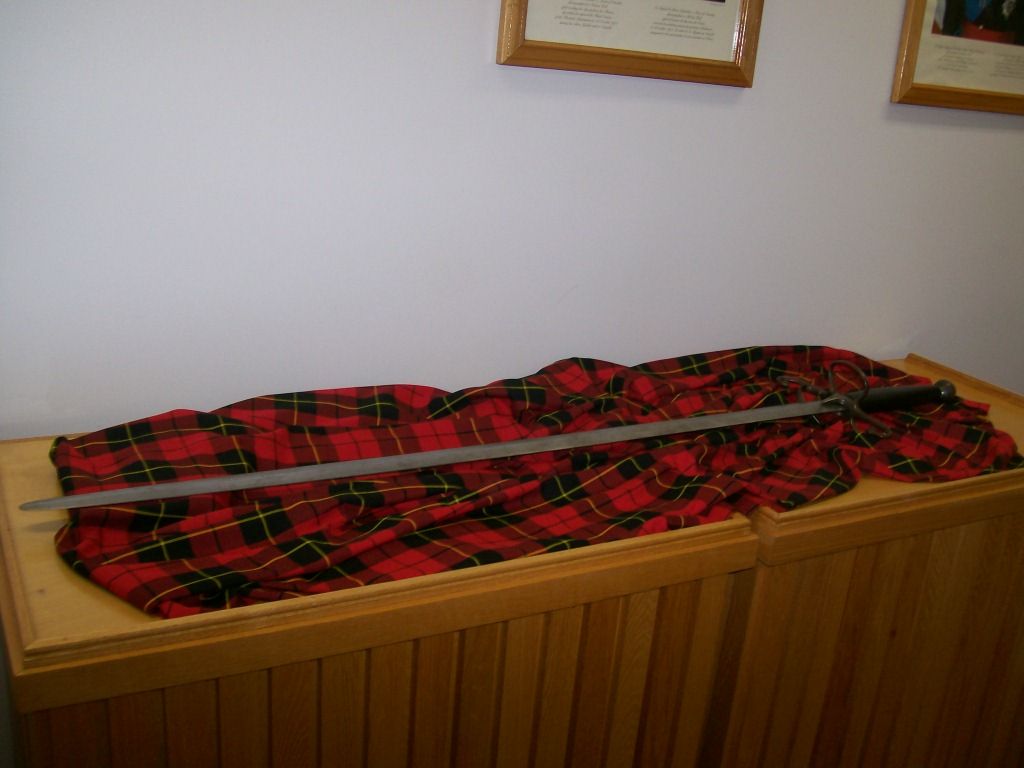|
-
21st April 13, 10:10 AM
#1
Picture of me holding a copy of the William Wallace Sword
Sorry folks this is the Wallace sword came to my home town, I JUST stumbled upon the pictures these are several years ago and I'm several pounds lighter  I just thought it was cool and that you guys would appreciate the coolness of it! I just thought it was cool and that you guys would appreciate the coolness of it!


Last edited by ThistleDown; 21st April 13 at 12:53 PM.
Reason: Request of OP
-
-
21st April 13, 10:54 AM
#2
A' Sheasaidh,
I normally have no interest whatever in weapons but could you tell us something of the history of this "Rob Roy Macgregor Sword". It is not the usual design of claidheamh mor (claymore = big cleaver) and indeed, as I understand it, the time span of such two-handed swords barely extends into Rob Roy's lifetime. Maybe some of the weapons experts could comment.
Alan
-
-
21st April 13, 11:00 AM
#3
I was wondering the same thing. It may be a copy of Rob Roy's sword, I don't know and I accept it for what you say it is, but it is certainly a larger sword than I imagined he carried.
" Rules are for the guidance of wise men and the adherence of idle minds and minor tyrants". Field Marshal Lord Slim.
-
-
21st April 13, 11:09 AM
#4
Sorry folks this is the Wallace Sword I had a slip in memory the article is here. I also got to meet Fergus who is involved with the Scottish wool heritage museum 
http://www.novanewsnow.com/section/2...apolis-Royal/1
-
-
21st April 13, 11:20 AM
#5
Ah that's better, thank you. Wallace's sword sits better on my mind. 
" Rules are for the guidance of wise men and the adherence of idle minds and minor tyrants". Field Marshal Lord Slim.
-
-
21st April 13, 11:22 AM
#6
OK, that makes sense now. We should have guessed - it's lying on Wallace tartan (though, of course, that's a bit of an anachronism)!
However, this
http://en.wikipedia.org/wiki/Wallace_Sword
has a lot of "alleged"s and "purported"s in it. Certainly, as mentioned, the hilt is not original.
(Doesn't detract from the nice picture, by the way!)
Would it be possible to change the thread title - ? with moderator help?
Alan
Last edited by neloon; 21st April 13 at 11:35 AM.
-
-
21st April 13, 12:42 PM
#7
Wow. Things were scary then! Thanks for sharing the photos. Five and a half feet!
-
-
21st April 13, 12:54 PM
#8
 Originally Posted by neloon

OK, that makes sense now. We should have guessed - it's lying on Wallace tartan (though, of course, that's a bit of an anachronism)!
Would it be possible to change the thread title - ? with moderator help?
Alan
Done
-
-
22nd April 13, 09:58 AM
#9
Thanks for the post and pictures Jess, and also to you Bren for the historical information. Interesting stuff.
Nile
-
-
22nd April 13, 10:15 AM
#10
-
 Posting Permissions
Posting Permissions
- You may not post new threads
- You may not post replies
- You may not post attachments
- You may not edit your posts
-
Forum Rules
|
|
Bookmarks